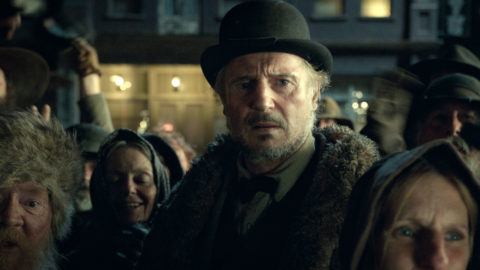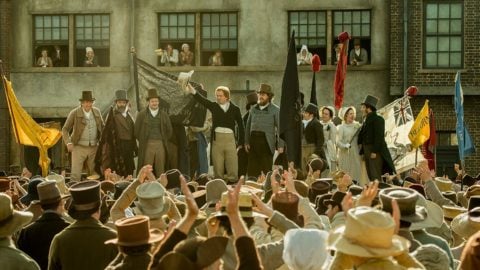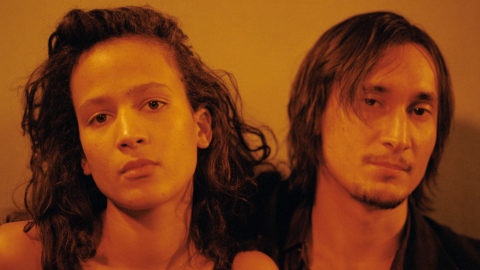Interview: Dick Pope
This interview is part of a series with influential cinematographers who attended the 2018 EnergaCAMERIMAGE International Film Festival in Bydgoszcz, Poland.
Nearing the third decade of their collaboration that began with 1990’s Life Is Sweet, Mike Leigh and Dick Pope continue to be one of modern cinema’s most ingenious and multifaceted director-cinematographer pairs. In Peterloo, their follow-up to the lavishly realized Mr. Turner (2014)—a portrait of the idiosyncratic 19th-century painter—they rise to the challenge of reconstructing a neglected event that has left its scar on the British collective consciousness. The most costly undertaking of Leigh’s career, the three-hour historical movie was commissioned to commemorate the 200th anniversary of the Peterloo Massacre, the government crackdown of a democracy rally in Manchester’s St. Peter’s Field. A firmly contextualized account of the creation of a political identity, Peterloo also functions as a subterranean allegory of contemporary traumatic experiences. As usual in Leigh’s films, Pope’s approach to the cinematography is characterized by a mixture of poised realism influenced by his early documentary experience, and heightened visual moments that break with naturalistic representation to convey the metaphysical and the psychological. After Peterloo’s screening at EnergaCAMERIMAGE in November, I spoke with Pope about the formal rigor and intuitive understanding he brings to working with Leigh’s established methods.
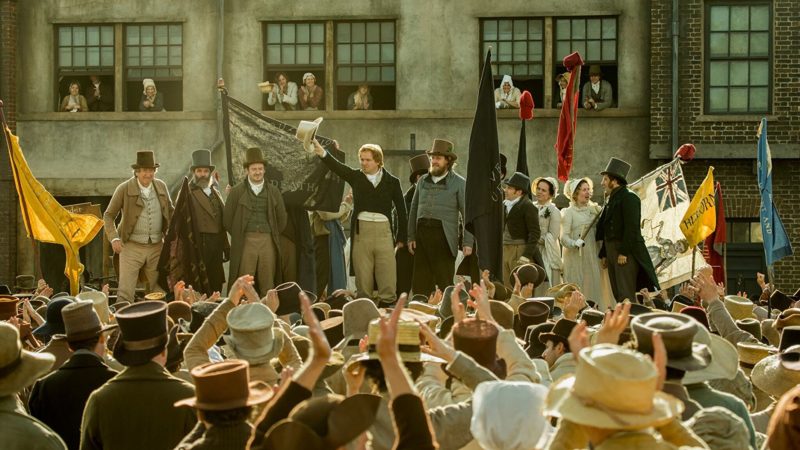
What was your guideline for defining the aesthetic of Peterloo, and did any aspects of your approach on Mr. Turner transfer onto that film?
Peterloo takes place only half a century before Mr. Turner, so I didn’t veer very far from what I had done there. I took the feeling of Mr. Turner and tweaked it a bit and then more. I used the Turner look, so to speak, as a benchmark. I didn’t use the same lenses, Cooke Panchros, but Leica’s Summicrons, because they’ve got a flatter look, and I used the digital Alexa camera to shoot the film. There was a famous illustrator at the time [in the early 19th century] called George Cruikshank. He was a cartoonist and satirist, who evoked in his illustrations what the Peterloo Massacre had been like. He wasn’t there himself, but relied on reportage of the event that was passed down. And his illustrations became iconic in my research for the right look for Peterloo. They’re quite flat and two-dimensional images of the bloodshed going on all around. You’ve got crowds, dragoons, and Hussars on horseback, and the people on the hustings, fighting in the background. So I used that kind of feel for the massacre sequence: a longer lens, flatter look from further back, slightly Kurosawa style. I also looked at documentary footage of the U.K. miners’ strike in 1984, where mounted police went into the miners and ripped them apart. It was really savage and brutal, and there’s fantastic newsreel footage of that, which I shared with Mike [Leigh]. What I saw in there was as important as what I saw in Kurosawa and Cruikshank.
Peterloo is an ensemble narrative with multiple contrasting perspectives. How did you go about visually distinguishing the worlds of the working class, the reformers, the magistrates, and the aristocrats?
Obviously, when you’re talking about the working classes and their lives, the environment in which they lived is a [key] element for production and costume design: their hovels and tenement-type rooms with small windows, and the factories with no windows at all. The coloration came from the clothes and fabrics the rich would wear. The working class wore rags and no color at all, and then you had the pompous magistrates and their families with the finery. So there were these different levels of society, and the production design placed them in the context of where they lived, who they were, and where they worked, and it all kind of fell into place.
What did the absence of a script entail in the case of a massive filmmaking effort like Peterloo?
Mike’s conjuring up process with the actors pretty much becomes the script itself, but I don’t have a sneak preview of any of it. I only see the scene when he brings it to set, after he’s rehearsed and laid it out with the actors. So he presents it to me as a finished piece, whether it’s a day’s or a week’s work, or a really long scene, and we work out how to shoot it. Then Mike goes off with the actors to refine that scene even more, and comes back after the lights and camera have been set up. While Mike and the actors are rehearsing, I do my own tests, perhaps see some locations that are being thought about. Sometimes I go to the locations before Mike has seen them, and try to give him my honest opinion. Then Mike often takes the actors to the locations, and that’s really the whole bag of tricks in terms of how we work.
But you can imagine how tricky the massacre in Peterloo was, because there’s hundreds of people there—actors, horsemen, stunt people. I used three cameras, very much thinking of Kurosawa and the way he did his battle scenes. He had this technique of three cameras: one wider, one tighter, and one wild. I think we would have probably come to that conclusion anyway, but it was a great technique that we used all the time on the massacre.
Being exposed to such violence after two hours of political discourse has a disturbingly cathartic effect, so I imagine you wanted the camerawork to be imbued with a feeling of eruption and cataclysm.
Mike wouldn’t even let us storyboard that sequence. So my main underlying fear was: “How in God’s name are we going to do this?” [Laughter] It took us four weeks to shoot it and it was all supposed to happen in two hours, from the time the people arrived on the square and took their place on the hustings until the dead were lying there. My challenge was how to make that four week shoot evoke two hours on a hot sunny day in 1819, because it all took place in the midday heat of August. But we had a terrible British summer, with clouds, and wind, and rain, so we had to stop sometimes. The covering of the square was cobblestones, so they had to put earth on it to make it possible for the horses to ride. But all this earth would become sodden with rain and wouldn’t kick up anymore: it was an absolute bloody nightmare. I didn’t have any sunlight at all, so I had to light the scene artificially with big units above. It was like a stage set with rows of big Brute lamps that were all pouring down and evoking sunlight.
I’ve read that the buildings around the square were inserted digitally.
They built everything to two stories, so the actors were put against the reality of the background, and what’s above was augmented later in post. So the way people are hanging out the windows and watching the events was all proper. Mike has to have complete control over the space, so they found a private place which we could take over for three months, including prep, and we used it as a kind of studio backlot.
I was very moved by your rendition of the traumatized young soldier’s death. We see him fall down from behind, but the camera stays locked in place, and we catch a blurry glimpse of him and his family through the galloping horse legs. It’s an unsentimental yet lyrical treatment that likens his post-Waterloo existence to that of a ghost.
Yes, it’s like he was already dead on the battlefield of Waterloo, and his PTSD made him a ghost.
While filming the carnage, did you feel as though you were giving voice to the present through the past?
Mike might have felt that, but I didn’t, because I was 100 percent focused on trying to make this a consistent sunny scene in the shitty weather we had. [Laughs] I was completely obsessed by this, morning, noon, and night. Setting up the shots was really complicated, and everybody would have to leave when Mike rehearsed with the actors in that great big field. Then we would come back to watch the scene and after that we brought in the extras, the horses, and the stunt people—it was a whole rigmarole for every single event that took place. But as opposed to just waving the camera around and seeing what you get, what this [method] gives you is a true structure. So the mayhem and chaos here are really structured, and [it all culminates in] the big shot at the end, when the camera goes round and round—that’s something I brought to the table on our last day. All the elements were in place, and I was always thinking of how we could end this. Suddenly I had this idea, which I discussed with Mike, and we built a circular track. The sun was just setting and the horses were rearing, with the crowd in the background. So the whole thing was layered, almost like a George Cruikshank illustration, and we went around it with the camera like a carousel.
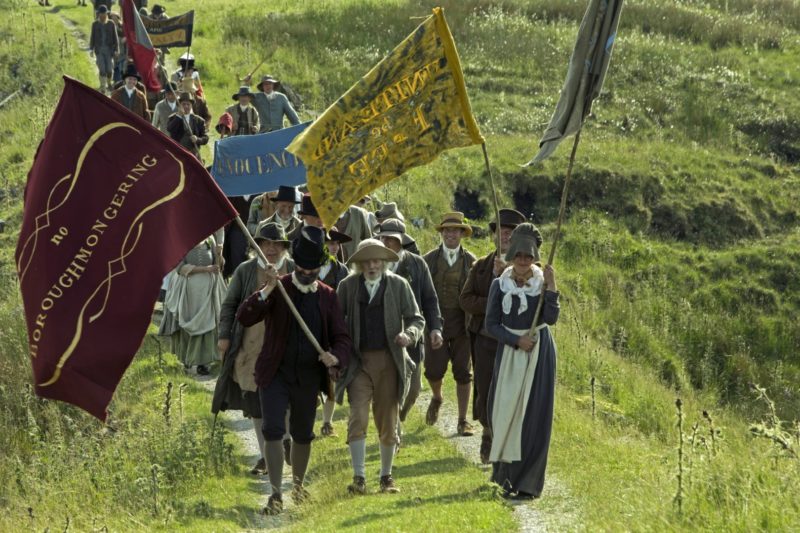
Were you trying to evoke the point of view of the dead?
Yes, certainly. We wanted the shot to have a surreal and expressionistic feel to it.
There was one scene that especially stuck with me. It’s the second verdict in the court montage at the beginning of the film, with one shot zooming away from the young convict and another into the magistrate’s face. The tension builds up, and I thought: “Here’s a moment in which the zeitgeist is expressed through purely cinematic means.” I wished for more of this abstract, gestural quality throughout…
I don’t know why we did that, but I think it’s nice for it to stand out. The cruelty of that magistrate and the way he was dealing with that guy just called for that way of filming. We do move the camera a lot in this film, but they’re all subtle and motivated movements. They’re not standout ones—pushing into people is not something we do that much. But we also have drone shots in there: we went mad in Yorkshire… [Laughter] We talked early on about doing some of the massacre with drones, but then rejected it. In that massacre, we never go out or look down at it from an objective point of view. We’re always looking along and compressing it.
I’m also wondering about your approach to shooting the political meetings. Was the coverage in those scenes precisely mapped out, or was it more a product of intuition, given that you couldn’t always anticipate the dynamics that would flow from the presence of so many people in the same room?
They were all carefully structured, and we had multiple cameras on a lot of those scenes as well since there was so much going on. But the actual arrangement of the scenes and the mise en scène is just something we do with Mike. It’s very difficult to take Peterloo out of all the other work we’ve done together, because for me it all adds up to each other, and we have shorthands as to how we look at situations. This film took three and a half years to make, but all of Mike’s films do, really. I’ve always said you wouldn’t get rich in waiting to work with Mike, so I often go out and do plenty of other stuff. Otherwise I’d be sitting at home for a long time. [Laughter]
Yonca Talu is a filmmaker living in Paris. She grew up in Istanbul and graduated from NYU Tisch.



